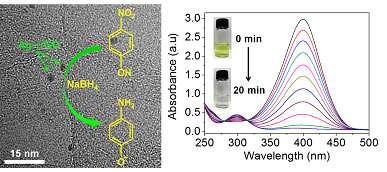Silver nanoparticles on graphene oxide support

Silver (Ag) has a high catalytic activity towards many organic and inorganic transformations such as NOx reduction and catalytic oxidation of CO to CO2. In practical applications, catalysts like Ag are affixed to a substrate, usually a solid with a high surface area such as alumina or carbon.
To efficiently use Ag as a catalyst, its specific surface area must be maximized by reducing its particle size. Moreover, the development of simple and low-cost synthesis method is highly desired for practical applications.
Now, Tran Viet Thu and colleagues at Toyohashi University of Technology have shown that graphene oxide (GO) sheets can be used as an excellent support for the growth of Ag particles. GO was first prepared from commercial graphite by oxidation and exfoliation in water. Then the Ag-GO hybrids were prepared by a chemical reduction route using GO and silver nitrate as precursors, sodium borohydride as reducing agent, and trisodium citrate as stabilizer.
Transmission electron microscopy imaging showed very small size (3.6±0.6 nm) Ag particles to be decorated on GO sheets, compared with Ag particles synthesized without GO (tens of nm in size). This decrease in particle size means more Ag atoms were present at the surface and a large increase in the specific surface area. As a result, the Ag-GO hybrids were more efficient for the catalytic conversion of 4-nitrophenol (toxic pollutant) into 4-aminophenol, an intermediate for the production of several drugs. In addition, the Ag-GO hybrids exhibited improved catalytic activity compared to Ag particles synthesized without GO.
The research suggests a low-cost route for the synthesis of catalytic Ag-GO hybrids and highlights the promising use of GO as a support for other functional nanostructures.
More information: Tran Viet Thu, Pil Ju Ko, Nguyen Huu Huy Phuc, and Adarsh Sandhu." Room-temperature synthesis and enhanced catalytic performance of silver-reduced graphene oxide nanohybrids."Journal of Nanoparticle Research 15 (10), 1-13 (2013). (DOI): 10.1007/s11051-013-1975-9.
Journal information: Journal of Nanoparticle Research
Provided by Toyohashi University of Technology





















